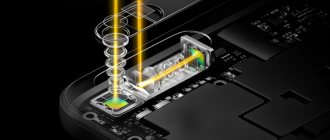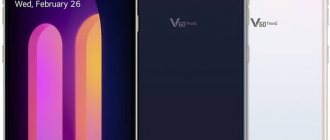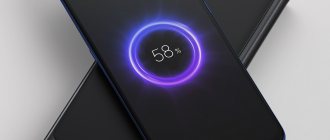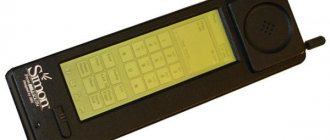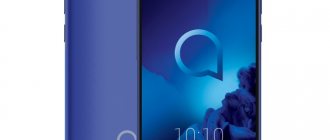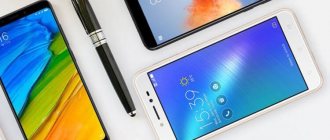Apple iPhone 12 Pro Max
- screen: 6.7″ (2778×1284) 60 Hz
- RAM: 6 GB
- memory: 512 GB
- 3 cameras: 12 MP, 12 MP, 12 MP
- battery: 3867 mAh
- processor: Apple A14 Bionic
- SIM cards: 2 (nano SIM+eSIM)
- operating system: iOS 14
- wireless interfaces: NFC, Wi-Fi, Bluetooth 5.0
- Internet: 4G LTE, 5G
- degree of protection: IP68
The 2021 ranking of frameless smartphones opens with the premium iPhone, whose screen-to-body ratio reaches 87.4% .
If you are a photographer or a blogger, choosing among the top 10 bezel-less smartphones is easy as the Max offers numerous camera features that will turn any photo and video into a work of art.
These include:
- 5x optical zoom,
- telephoto with ƒ/2.2 aperture,
- optical image stabilization by matrix shift (for a wide-angle camera),
- digital zoom up to 12x,
- night mode for portraits with the LiDAR scanner enabled,
- shooting HDR video in the Dolby Vision standard at up to 60fps,
- and slow-motion video support for 1080p at 240 fps.
The 12 Pro Max features Apple's flagship A14 Bionic chip, which delivers fast app loads, excellent multitasking, and the ability to easily run even the most demanding workflows.
Pros : complete moisture and dust protection, supports wireless charging with MagSafe technology and regular Qi wireless charging, fast charging, loud and clear sound from stereo speakers.
Cons : The biggest drawback of the iPhone 12 Pro Max is obvious - it's expensive.
In addition, its screen has a refresh rate of 60 Hz, although less expensive competitors can offer 120 and even 144 Hz.
iPhone SE 2021
- Display: 4.7”,1334×750 pixels
- SoC: Apple A13 Bionic
- RAM: 3 GB
- Permanent memory: 64 GB
- Main/front camera: 12 MP/7 MP
- Battery: 1812 mAh
- OS: iOS 13
Price: from 31,599 rubles
This seems funny, but among the best smartphones without a unibrow was a new product from Apple - iPhone SE 2021. After all, it was this company that relatively recently introduced the fashion for cutouts in screens with its iPhone X, and now it is partly moving away from this trend.
The iPhone SE 2021 copies the design of the iPhone 8, so it has wide bezels at the top and bottom. There is also a mechanical Home button with a fingerprint scanner, a single main 12-megapixel camera and a 7-megapixel selfie camera. The filling has been updated and is the Apple A13 Bionic processor, which is also installed in the iPhone 11, iPhone 11 Pro and iPhone 11 Pro Max models. The RAM was set to 3 GB, and the built-in memory was at least 64 GB. But the battery is rather weak (1812 mAh) and this is the bane of all iPhones, so the latest budget option is also not left out.
Advantages:
- Signature familiar design.
- Super compact size.
- There is NFC.
- Powerful flagship processor.
- There is fast charging.
- Adequate cameras.
- Smooth operation of the system.
Flaws:
- Weak battery.
- Wide frames around the display.
- High price.
HONOR 30 Pro+
- screen: 6.57″ (2340×1080) 90 Hz
- RAM: 8 GB
- memory: 256 GB, memory card slot
- 3 cameras: 50 MP, 8 MP, 16 MP
- battery: 4000 mAh
- Processor: HiSilicon Kirin 990 5G
- SIM cards: 2 (nano SIM)
- operating system: Android 10
- wireless interfaces: NFC, Wi-Fi, Bluetooth 5.1
- Internet: 4G LTE, 5G
- degree of protection: IP54
One of the most frameless smartphones of 2021, whose front surface area is 89.8% , boasts a 6.67-inch AMOLED display with a refresh rate of 90 Hz. At the same time, the screen is very bright and has extremely high contrast.
The Honor 30 Pro+ has a 50-megapixel main camera (Sony IMX700) with optical stabilization, an 8-megapixel periscope-style telephoto lens with optical stabilization, a 16-megapixel ultra-wide-angle camera and another macro camera.
By default, the camera shoots in 12.5MP mode, and we recommend this mode as it provides better detail than the maximum 50MP. A TV module with 5x optical zoom will allow you to clearly see even distant objects, and the maximum digital zoom is 50x.
On the front panel there is a combination of a 32-megapixel camera and an ultra-wide-angle lens. It has autofocus and provides excellent image quality (although the sharpness drops noticeably towards the edges of the picture).
The HiSilicon Kirin 990 chipset can handle any game that is on the AppGallery. And thanks to the VC liquid cooling system, you can play as much as you need without worrying about your smartphone burning your palm.
Pros : IR port, 40-watt fast charging, reverse wireless charging, and 27 W fast wireless charging, you can install an NM memory card instead of one of the SIM cards.
Cons : no Google services, no 3.5 mm audio jack, no full moisture protection.
Huawei P Smart Z
What is good about this smartphone besides the screen without cutouts and holes
In this smartphone, the issue of “limitless” screen was solved radically - due to the selfie camera coming out of the body. Otherwise, the smartphone turned out to be quite simple, but at the same time balanced, which is why it is still a very popular smartphone, although it was released in 2021. The display of the Huawei P Smart Z is large, 6.6 inches, and the model is one of the most “large-screen” in its class. The quality of the cameras can be considered a plus rather than a minus. The positive part of the picture is complemented by a 4000 mAh battery (this is just a normal battery for such a diagonal, but it cannot be called very powerful) and NFC support. Well, let’s remember the support for Google services - for Huawei smartphones this is now also a big plus.
What you have to come to terms with
There was no room for a separate microSD slot, so to install a flash drive you will have to sacrifice one of the SIM cards. The back panel of the case is plastic, although at this price you can already count on glass. Well, the number of cameras is not the maximum - some competitors have three or even four on the back.
Huawei P Smart Z
Realme 7 Pro
- screen: 6.4″ (2400×1080) 60 Hz
- RAM: 8 GB
- memory: 128 GB, memory card slot
- 4 cameras: 64 MP, 8 MP
- battery: 4500 mAh
- processor: Qualcomm Snapdragon 720G
- SIM cards: 2 (nano SIM)
- operating system: Android 10
- wireless interfaces: NFC, Wi-Fi, Bluetooth 5.1
- Internet: 4G LTE
One of the best Realme smartphones of 2021 features a 90.8 percent screen-to-body ratio as stated in its specifications.
The 6.4-inch display is a bright and contrasty AMOLED panel with 409 ppi. However, it has a refresh rate of 60 Hz, which is not particularly good when there are competitors in the price range up to 30,000 rubles, but with screens with a frequency of 90 Hz and 120 Hz. Even the less expensive Realme 7 has a 6.5-inch IPS display with a 90Hz refresh rate.
The front camera is discreetly located in a tiny hole in the top left corner of the screen and can be used for face unlock. Alternatively, you can use the in-display fingerprint scanner - a welcome feature in such an inexpensive phone.
Realme 7 Pro is powered by the mid-range Snapdragon 720G chipset with 8GB of RAM. In the Geekbench 5 CPU test, it scored 576 (single-core test) and 1790 (multi-core test), which is quite good.
There is a special area for games called Game Space. Add games and you can customize settings like power consumption and incoming calls for a more personalized and immersive gaming experience.
The front camera has a resolution of 32 MP and an f/2.5 aperture, and at the back there is a block of four cameras:
- 64-megapixel wide-angle f/1.8;
- 8 MP f/2.3 ultra-wide angle (119 degrees);
- 2 MP f/2.4 macro (fixed focal length 4 cm);
- 2 MP f/2.4 black and white.
Photos taken with the main camera have a wide dynamic range (which can be further adjusted using the AI Vivid Colors feature) and good color reproduction.
Pros : 3.5 mm audio jack, stereo sound, dedicated memory card slot, no advertising in the shell, super-fast charging 65 W included, high performance.
Cons : Plastic body, no IP rating for dust/water resistance.
Sony Xperia 1 and Sony Xperia 5
Sony Xperia 1 Specifications:
- Display: 6.5”, 4K
- SoC: Snapdragon 855
- RAM: 6 GB
- Permanent memory: 64/128 GB
- Main / front camera: 12+12+12 MP / 8 MP
- Battery: 3330 mAh
- OS: Android 9.0 Pie
Xperia 5 Specifications:
- Display: 6.1”, Full HD+
- SoC: Snapdragon 855
- RAM: 6 GB
- Permanent memory: 128 GB
- Main / front camera: 12+12+12 MP / 8 MP
- Battery: 3140 mAh
- OS: Android 9.0 Pie
Price: from 59,990 rubles
Xperia 1 and Xperia 5 turned out to be very similar to each other, since both models got a full-screen design with thin frames. The Xperia 5 (pictured above) is a more recent model, it has a 6.1-inch screen with Full HD+ resolution, 6 GB of system memory and three main lenses of 12 MP each. Its main advantages are IP68 water protection and the ability to expand permanent memory using microSD cards. To protect user data, a side-mounted fingerprint scanner is used, built into the power button.
The Sony Xperia 1 starts with a 6.5" widescreen display with 4K resolution. this model also applies to smartphones without a unibrow. The increased dimensions have a positive impact on battery life: the battery holds 3330 mAh versus 3140 mAh for the Xperia 5. Other characteristics, including the chipset model and camera features, are no different from the Xperia 5.
OnePlus 8 Pro
- screen: 6.78″ (3168×1440) 120 Hz
- RAM: 12 GB
- memory: 256 GB
- 4 cameras: 48 MP, 8 MP, 48 MP, 5 MP
- battery: 4510 mAh
- Processor: Qualcomm Snapdragon 865
- SIM cards: 2 (nano SIM)
- operating system: Android 10
- wireless interfaces: NFC, Wi-Fi, Bluetooth 5.1
- Internet: 4G LTE, 5G
- degree of protection: IP68
This premium smartphone comes with a stunning AMOLED display with curved edges and extremely narrow bezels.
The 120Hz refresh rate makes the screen experience super smooth, and the surface utilization rate reaches 91.0% . The peak brightness of 1300 nits is also impressive, making it easy to read text on the screen on the sunniest day. There is also a very fast fingerprint scanner on the screen.
Ultra-fast wired charging Warp Charge 30T allows you to charge the device up to 50% in 28 minutes, and a full charge takes 77 minutes. The 8 Pro can also charge other Qi-enabled devices from its rear panel.
The phone is equipped with an eight-core Snapdragon 865 chipset, and can easily handle several open applications or the most resource-intensive game at maximum graphics settings.
The main 48-megapixel camera of the smartphone takes excellent, detailed and well-exposed photos.
The 48-megapixel ultra-wide-angle camera delivers good shots in bright light in its 12-megapixel mode. She can also use Nightscape to brighten very dark scenes.
The third 8-megapixel camera has 3x hybrid zoom, and additional digital zoom up to 30x.
Finally, the 5MP camera with photochromic color filter is a gimmick that you can safely ignore and produces poor images even in good light.
The front-facing 16-megapixel camera provides detailed images in good lighting.
Pros : Warp Charge 30 wireless charging, 5G support, beautiful and comfortable shell, performance, excellent rear and front cameras.
Cons : no 3.5 mm audio jack, cannot install a memory card.
Asus ROG Phone 2
- Display: 6.59”, FHD+
- SoC: Snapdragon 855 Plus
- RAM: 12 GB
- Permanent memory: 256 / 512 GB or 1 TB
- Main / front camera: 48+13 MP / 24 MP
- Battery: 6000 mAh
- OS: Android 9 Pie
Price: 69,990 rubles
The line between truly gaming and simply powerful smartphones has already blurred, but the second generation of ROG Phone, like the first, is aimed at the gaming audience. The smartphone has the most advanced technical characteristics to date, it has impressive battery life, and a widescreen 6.59” AMOLED display with a refresh rate of 120 Hz. The gaming focus can also be seen in the design: the case looks catchy, and on the back cover there is an RGB logo with the possibility of customization.
The smartphone is built on Snapdragon 855 Plus with 12 GB of RAM and 512 GB of storage. It went on sale in September, and at the moment there are a decent number of accessories developed for it, for example, a TwinView docking station with an additional 6.6” screen and a 6000 mAh battery.
Samsung Galaxy Note 20 Ultra
- screen: 6.9″ (3088×1440) 120 Hz
- RAM: 12 GB
- memory: 512 GB, memory card slot
- 4 cameras: 108 MP, 12 MP, 12 MP
- battery: 4500 mAh
- processor: Samsung Exynos 990
- SIM cards: 2
- wireless interfaces: NFC, Wi-Fi, Bluetooth
- Internet: 4G LTE, 5G
Samsung's latest premium smartphone features a stunning AMOLED screen with a 91.7 percent body-to-body ratio , and dedicated features for the included S Pen stylus.
The S Pen itself has new useful features, such as syncing voice notes with your handwritten notes (students, journalists, and workers who often sit in on meetings will surely love this).
The screen on the Galaxy Note 20 Ultra has a refresh rate of 120 Hz (at FullHD+ resolution), but at maximum resolution the refresh rate drops to 60 Hz.
Samsung Galaxy Note 20 Ultra is the first smartphone on the market to use Gorilla Glass Victus protection. It is more resistant to falls and scratches, but you should not overestimate it and refuse a protective case.
The main camera of the Samsung Galaxy Note 20 Ultra is impressive, to say the least. It has 5x optical zoom, 50x digital zoom and an easy to use interface. We also note the ability to shoot video with a resolution of 8K and super smooth videos at 120 frames per second.
The selfie camera has a wide viewing angle - you don’t need to move your hand far with the phone. The pictures are very detailed, with good white balance and natural color rendition.
If the Note 20 Ultra has a weak point, it's the battery. In most countries around the world, the phone comes with the Samsung Exynos 990 chipset, which, although it has top-end performance, cannot boast of top-end energy efficiency. And if you actively use your smartphone, you will have to charge it before the end of the day. Fortunately, with fast 25-watt or wireless 15-watt charging, it won’t take much time. This model also has 4.5 W reverse charging.
Pros : you can install a memory card, although you will have to sacrifice one of the SIM cards, 5G support, full dust and water protection according to the IP68 standard, flagship performance, Always On Display, excellent sound thanks to AKG stereo speakers with support for Dolby Atmos technology.
Cons : lack of a standard 3.5 mm headphone jack, gets warm under load.
Google Pixel 3a and Pixel 3a XL
Google Pixel 3a Specifications:
- Display: 5.6-inch, Full HD+
- SoC: Snapdragon 670
- RAM: 4 GB
- Permanent memory: 64 GB
- Main / front camera: 12.2 MP / 8 MP
- Battery: 3000 mAh
- OS: Android 9.0 Pie
Google Pixel 3a XL Specifications:
- Display: 6.0”, Full HD+
- SoC: Snapdragon 670
- RAM: 4 GB
- Permanent memory: 64 GB
- Main / front camera: 12.2 MP / 8 MP
- Battery: 3700 mAh
- OS: Android 9.0 Pie
Price: from 28,830 rubles
If you choose a smartphone without a notch, focusing solely on performance, the Pixel 3a and 3a XL are unlikely to seem ideal options. Both of them belong to the mid-budget category. And yet, they have enough power to cope with the demands of the average user. They were included in this list for two reasons. Firstly, these are smartphones without a unibrow. And secondly, the Pixel 3a and Pixel 3a XL are excellent devices for mobile photography.
They got the camera from the flagship Pixel 3 and 3 XL. In the price range up to 35 thousand, it is difficult to find a device that would shoot so well in low light conditions. The update with Google's new Astro Mode for capturing the night sky makes them an even more attractive choice.
Pixel 3a and 3a XL run on stock Android with integrated Active Edge technology: calling the Google Assistant voice assistant is done by squeezing the side edges of the case. Disadvantages include the lack of water protection and wireless power. The plus is the presence of an audio jack.
The main differences between the base Pixel 3a and its enhanced version lie in the display and battery features. The base model has a 5.6" screen and a 3000 mAh battery, while the XL has a larger 6" display and a 3700 mAh battery.
Xiaomi Mi 11
- screen: 6.81″ (3200×1440) 120 Hz
- RAM: 8 GB
- memory: 256 GB
- 3 cameras: 108 MP, 13 MP, 5 MP
- battery: 4600 mAh
- Processor: Qualcomm Snapdragon 888
- SIM cards: 2 (nano SIM)
- operating system: Android 11
- wireless interfaces: NFC, Wi-Fi, Bluetooth 5.2
- Internet: 4G LTE, 5G
New to the top 2021 frameless smartphones, it stands out for its huge front panel with a 92.4 percent body-to-body ratio . The OLED screen has a 120Hz refresh rate, with Xiaomi citing DisplayMate testing to claim it's one of the best mobile displays out there right now.
For comparison, the previous flagship Mi 10 Pro received an OLED panel with FHD + resolution and a 90 Hz refresh rate.
Along with the updated screen, Xiaomi Mi 11 also received excellent sound quality. It is provided by stereo speakers, in the adjustment of which Harman Kardon participated.
The main camera has a resolution of 108 MP and has optical stabilization; it comes complete with a 13 MP ultra-wide camera (123 degree field of view) and a 5 MP telephoto lens. You also get features like 8K recording and night time lapse.
Mi 11 is equipped with a top-end Snapdragon 888 processor and an Adreno 660 graphics processor. This combination can easily handle heavy mobile games such as League of Legends at 60 fps and above.
Pros : top-end performance, IR blaster, super-fast 55W wired charging, 50W wireless charging and even 10W reverse wireless charging, LED notification light.
Cons : advertising in the shell, no 3.5 mm audio jack, no IP rating, wireless charger must be purchased separately.
Huawei Y5 Prime (2018)
- Display: 5.45”, HD+
- SoC: MediaTek MT6739
- RAM: 2 GB
- Permanent memory: 16 GB
- Main / front camera: 13 MP / 5 MP
- Battery: 3020 mAh
- OS: Android 8.1
Price: from 5,500 rubles
Huawei Y5 Prime (2018) is an excellent ultra-budget smartphone without bangs in our selection. Therefore, if you are annoyed by cutouts and so on, and you need a phone that is as cheap as possible, then pay attention to this model. True, at the same time you will have to endure not the thinnest frames, but maybe for some it is better than bangs.
Huawei Y5 Prime (2018) is powered by a MediaTek MT6739 processor with 2 GB of RAM and 16 GB of internal memory, which is quite good for this price category. The HD+ resolution is also decent, especially since the screen is 5.45 inches and the size is compact, which is a rarity in 2021. But the battery is only 3020 mAh, although for this diagonal it is also normal and will be enough for a full day of work.
Advantages:
- Low price tag.
- The battery is normal for this diagonal.
- Powerful processor.
- There is fast charging.
- Good selfie camera on a retractable module.
- Good main camera.
- Thin bezels around the display.
Flaws:
- No NFC.
- Little RAM and ROM.
- No USB Type-C port.
- Weak processor.
- Mediocre cameras.
- Thick frames around the screen.
OPPO Reno 10x Zoom
- screen: 6.6″ (2340×1080)
- RAM: 8 GB
- memory: 256 GB, memory card slot
- 3 cameras: 48 MP, 8 MP, 13 MP
- battery: 4065 mAh
- Processor: Qualcomm Snapdragon 855
- SIM cards: 2 (nano SIM)
- operating system: Android 9.0
- wireless interfaces: NFC, Wi-Fi, Bluetooth 5.0
- Internet: 4G LTE
What really makes the Oppo Reno 10X Zoom special is the 10x periscope-style hybrid telephoto lens that sits alongside a 48MP Sony IMX586 main camera and an 8MP 120° ultra-wide-angle lens.
The Reno 10x Zoom also has a 16MP pop-up camera with an f/2.0 aperture that evokes a shark fin. Selfies turn out great even in artificial light or in the evening.
The elevating camera module makes room for the earpiece and LED flash. The result is a device with a huge AMOLED display without any annoying notches. The front panel occupies 93.1% of the area and will delight the owner with rich and bright colors, as well as the widest possible viewing angles.
Reno 10X Zoom has pre-flagship level characteristics, including Snapdragon 855 and Adreno 640 video accelerator. Another small but important advantage of this model is the ability to install a memory card, albeit in a hybrid slot.
Pros : unique design, protective film is already applied from the factory, the fingerprint scanner built into the screen works quickly and without failures, high performance, support for VOOC 3.0 fast charging, which will bring the charge to 100% in about an hour.
Cons : no wireless charging, a smartphone is easier to find on Aliexpress than in Russian online stores.
Vivo V15
- Display: 6.53”, Full HD+
- SoC: MediaTek Helio P70
- RAM: 6 GB
- Permanent memory: 64 GB
- Main/front camera: 12+8+5 MP/32 MP
- Battery: 4000 mAh
- OS: Android 9.0 Pie
Price: from 22,286 rubles
Vivo V15 was also equipped with a retractable module for the front camera, and thanks to its 32 megapixel resolution, this model can easily be considered a full-fledged selfie phone. The main camera is triple with 12, 8 and 5 megapixel sensors and here everything is normal or even sad.
The heart of the Vivo V15 is the MediaTek Helio P70 processor, which is supported by 6 GB of RAM and 64 GB of internal memory. The battery is also adequate - 4000 mAh. They didn’t forget the new Bluetooth 5.0 and NFC module for contactless payments, but for some reason they did everything poorly with the port and installed an outdated microUSB instead of USB Type-C, despite the fact that in this price category this is no longer acceptable.
Advantages:
- Lots of RAM and ROM.
- There is NFC.
- Adequate processor.
- There is fast charging.
- Excellent front camera.
- Thin bezels around the display.
- Stylish design.
- Decent battery.
Flaws:
- No USB Type-C port.
- Mediocre main camera.
- Not everyone will be comfortable with a retractable module.
- A bit overpriced.
HUAWEI P40 Pro Plus
- screen: 6.58″ (2640×1200) 90 Hz
- RAM: 8 GB
- memory: 512 GB, memory card slot
- 5 cameras: 50 MP, 40 MP, 8 MP, 8 MP
- battery: 4200 mAh
- Processor: HiSilicon Kirin 990 5G
- SIM cards: 2 (nano SIM)
- operating system: Android 10
- wireless interfaces: NFC, Wi-Fi, Bluetooth 5.1
- Internet: 4G LTE, 5G
- degree of protection: IP68
this beauty features an OLED screen and a refresh rate of 60Hz (to save battery) or 90Hz for smoother animations.
The P40 Pro+ is powered by the flagship HiSilicon Kirin 990 5G chipset. Therefore, there are no problems with performance, unless you run a dozen of the heaviest mobile games on it at the same time.
If you're willing to sacrifice a second SIM slot, you can further expand the internal storage with Huawei's proprietary Nano Memory (NM) cards.
The lack of Google Mobile Services on the entire P40 series means this phone lacks not only the Google Play Store, but also a host of Google apps, including Chrome, YouTube, Google Maps and Gmail.
Instead of GMS, there are Huawei mobile services complete with Huawei AppGallery, which is constantly filled with applications.
The main selling point of the P40 Pro+ is its camera system, which consists of a dual selfie camera and a penta camera at the rear.
Five rear cameras include:
- wide-angle 50 MP f/1.9 module;
- 40 MP f/1.8 ultra-wide-angle module;
- 8 MP f/4.4 super zoom (10x optical periscope zoom);
- 8 MP f/2.4 telephoto (3x optical zoom);
- time-of-flight (ToF) camera for determining the depth of a scene.
At the front, a 32MP f/2.2 wide-angle camera and a ToF depth sensor are housed in a notch at the top left corner of the screen.
Even for regular point-and-click shots, the main camera can take beautiful photos.
The smartphone supports fast charging (40W) and fast wireless charging (40W) with eligible Huawei chargers. Fast reverse wireless charging (27W) is also available.
Pros : complete water and dust protection, excellent quality of selfies and pictures/videos from the main camera, unique 10x optical zoom, ceramic body, does not get very hot under load.
Cons : lack of Google services, expensive branded memory cards, no 3.5 mm audio jack for headphones.
Vivo Nex 3
- Display: 6.89”, Full HD+
- SoC: Snapdragon 855 Plus
- RAM: 8 GB
- Permanent memory: 128 GB
- Main / front camera: 64+13+13 MP / 16 MP
- Battery: 4500 mAh
- OS: Android 9.0 Pie
Price: 59,990 rubles
Outside of China, Vivo is not very popular, but Vivo Nex 3 is able to compete with devices from famous brands, including even Huawei Mate 30 Pro. It has a 6.89” screen, a retractable front camera, a very powerful Snapdragon 855 Plus with 8 GB of memory for running applications. The Nex 3 comes in two versions to accommodate changes in mobile communications - with and without support.
Of the shortcomings, the software component stands out the most. FunTouch OS could be better if its creators did not try so hard to copy iOS, but thought more about the user experience. In addition, you should not expect much from the camera: despite the high resolution, software image processing does not work miracles.
Motorola Edge+
- Screen: 6.7″, curved, 2340×1080 (19.5:9)
- Memory: 256 GB,
- RAM: 12 GB
- Processor: 8 cores, Snapdragon 865, 2.84 GHz
- Camera: 108 MP, 16 MP, 8 MP, TOF
- Battery capacity: 5000 mAh
- Wi-Fi 802.11 a/b/g/n/ac, dual-band, Wi-Fi Direct, hotspot
- Cellular standards 2G, 3G, 4G LTE, 5G
- Moisture protection: IP54
After years of being in the mid-range segment, Motorola has finally returned to the market with a flagship with the Motorola Edge+. It has a Snapdragon 865 processor, a 90 Hz display and powerful cameras. The screen-to-body ratio is almost a record - 95.8% . Support for HDR10+ is announced, as well as a refresh rate of 90 Hz.
The main camera has a 108MP sensor, which allows it to capture excellent close-ups. It comes with an 8MP telephoto lens and a 16MP ultra-wide-angle lens. The camera can shoot video in 4K resolution at 30 frames per second. The front camera has a resolution of 25 MP and takes very bright selfies.
The Qualcomm® Snapdragon 865 processor makes the Motorola Edge+ one of the fastest smartphones on the market. You won't have any performance issues even if you run the heaviest mobile game at maximum settings.
Pros : 3.5 mm audio jack, pure Android 11, 5G support, you can make contactless payments, support for fast and wireless charging TurboPower 15 W, as well as reverse charging 5 W.
Cons : difficult to find on sale in Russia, plastic back panel is a shame for such an expensive device, you cannot install a memory card, only 1 SIM card.
Google Pixel 4 and Pixel 4 XL
Google Pixel 4 Specifications:
- Display: 5.7”, Full HD+
- SoC: Snapdragon 855
- RAM: 6 GB
- Permanent memory: 64/128 GB
- Main / front camera: 12.2+16 MP / 8 MP + ToF
- Battery: 2800 mAh
- OS: Android 10
Google Pixel 4 XL Specifications:
- Display: 6.3”, QHD+
- SoC: Snapdragon 855
- RAM: 6 GB
- Permanent memory: 64/128 GB
- Main / front camera: 12.2+16 MP / 8 MP + ToF
- Battery: 3700 mAh
- OS: Android 10
Price: from 59,990 rubles
The combination of top-end characteristics, well-developed software and fantastic photographic capabilities - all this puts the fourth series of pixels in the top mobile devices of 2021, which are still relevant in 2020. The front camera is implemented in a standard way - in a body without retractable platforms, and therefore the upper part of the frame is thicker than that of the OnePlus 7T Pro and Xiaomi Mi 9T Pro.
The Pixel 4 and 4 XL are among the best camera phones. They perform very well in the dark, thanks to Google Night Sight technology. As always with the new generation of pixels, Google is introducing a new software mode that expands the capabilities of the mobile photographer. This time, the addition was Astro Mode, designed specifically for shooting the starry sky.
The technical features of the Pixel 4 and 4 XL have many similarities - the same chipset, cameras and memory amounts. Both models run on pure Android and have long-term software support. The differences lie in the display diagonal and battery life: the Pixel 4 XL has both parameters increased.
How to choose a frameless smartphone
To choose the optimal smartphone model, pay attention to the following nuances:
- Screen size. Ease of use and transportation depends on this.
- Screen quality. Watching content on a faded screen with large pixels will not be enjoyable. IPS screens are safer for health, while OLED has lower consumption, true black color, a higher contrast picture, but is susceptible to PWM.
- Quality of case materials and assembly. Not only the appearance of the gadget, which is also important, but also its strength and durability depend on this.
- Performance. A smartphone should not only quickly solve assigned tasks, but also remain relevant for at least a year or two. The minimum requirements this year are 4GB of RAM and a processor no weaker than Qualcomm Snapdragon 665.
- Autonomy. This parameter is the time that the device can operate from full charge until the battery is discharged. We recommend choosing devices with a battery of at least 3500 mAh.
- Company manufacturer. It is better to refuse to purchase a smartphone from a little-known manufacturer, even if it is offered at a favorable price. Subsequently, problems may arise with stability, reliability and the search for spare parts.
- Quality and presence of stereo speakers. When watching video content, stereo speakers greatly benefit in quality compared to conventional ones.
- Protection from dust and moisture. The durability of the gadget largely depends on the degree of protection.
- Reviews. Before buying any smartphone, be sure to read good and bad reviews about it.
When compiling the rating of the best frameless smartphones, we took into account hardware performance, quality of components and user reviews, and also paid attention to the price/quality ratio and the number of sales.
Useful materials to choose from
ASUS ZenFone 4 Selfie Pro
ASUS ZenFone 4 Selfie Pro
The presented model of mobile device was developed for those people who like to take a lot of photographs and shoot videos. ASUS ZenFone 4 Selfie Pro is a smartphone with 2 front cameras.
The Sony IMX362 photo matrix, built into the gadget, takes high-quality selfies under any conditions (building, in the sun, at night).
Characteristics
The photomatrix has a photosensitivity that is 2 times higher than in other phones. The gadget has a built-in SuperPixel processor with automatic functions.
The smartphone is available in the following colors: gold, red and black. The case has factory branded engraving and protective glass. The design is elegant. The fingerprint scanning function works.
ASUS ZenFone 4 Selfie Pro captures high quality photos in any conditions
Advantages
A special feature of the presented smartphone is ultra-fast autofocus, which takes pictures in motion without blurring the images.
Also, the advantages of a mobile device include:
- 8-core processor.
- Memory – 4 GB.
- High-quality shooting.
- The rear camera is 16 MP in addition to the 2 front ones.
- Wide-angle camera with increased viewing area.
- LED flash.
- Photofunction of scattered light.
- 4K Ultra HD (for video).
- Fast charging.
- Powerful speakers with amplifier.
The device uses Adreno 506 (graphics processor) and a selfie editor (ASUS SelfieMaster application).
IMPORTANT! ASUS ZenFone 4 Selfie Pro is the best selfie model in terms of quality and technical specifications, allowing you to get perfect images.
The camera frame contains 2 times more details than a regular phone. The portrait mode feature gives your photos a unique look.
Nubia Red Magic 3S
- Display: 6.65”, Full HD+
- SoC: Snapdragon 855 Plus
- RAM: 8/12 GB
- Permanent memory: 128/256 GB
- Main / front camera: 48 MP / 16 MP
- Battery: 5000 mAh
- OS: Android 9.0 Pie
Price: from 41,800 rubles
The successor to the Red Magic 3 was a model called Red Magic 3S. It belongs to the gaming category, but will interest not only fans of mobile entertainment, but also those who are looking for a powerful smartphone without bangs with a unique design.
Inside the Red Magic 3S lies a Snapdragon 855 Plus with up to 12 GB of RAM and up to 256 GB of ROM, as well as a 5,000 mAh battery. The widescreen 6.65” AMOLED has Full HD+ resolution and a 90 Hz picture refresh rate. Gaming features of the device include a liquid cooling system, a built-in cooler, RGB lighting on the rear panel and two customizable side switches.
The Red Magic 3S's hardware allows it to compete with flagships from famous brands. And since this model has an abundance of computing power, Red Magic 3S can be a profitable purchase for several years to come.
